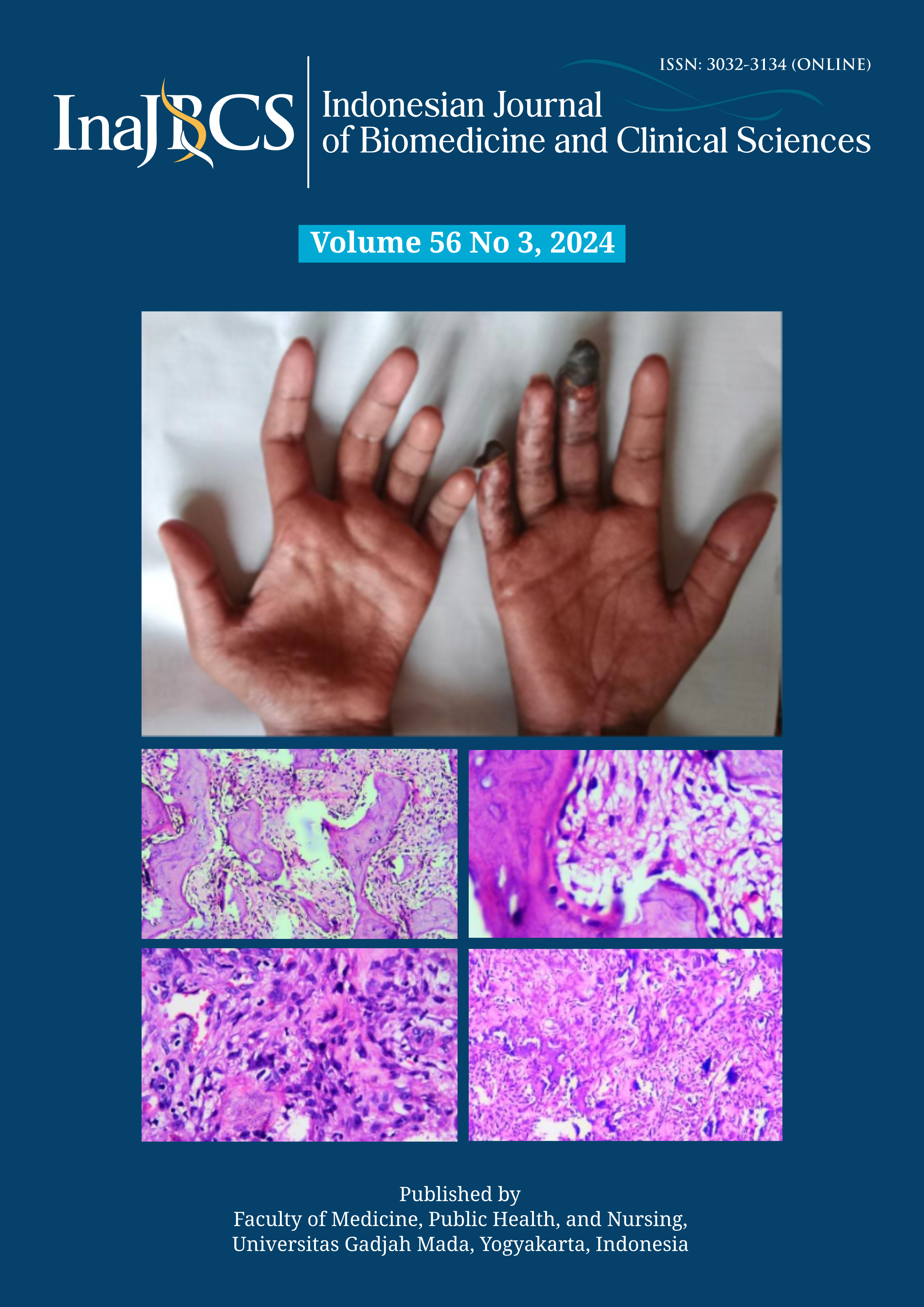Health comorbidities in children with down syndrome (DS) at Dr. Sardjito General Hospital, Yogyakarta
Abstract
Down syndrome (DS) is a disease caused by trisomy of chromosome 21. The phenotype in DS leads to manifestations in several organ systems. This study aimed to identify the pattern of comorbidities in DS patients. It was a single-center, cross-sectional study at Dr. Sardjito General Hospital, Yogyakarta. Medical records of pediatric patients with DS from a period of January 2022 to May 2023 were included. Descriptive analysis was performed to demonstrate demographic and clinical characteristics. A total of 355 pediatric patients with DS were found at Dr. Sardjito General Hospital and the majority were male (196 children or 55.2%). As much as 339 children (95.49%) had comorbidities. The highest comorbidity was congenital heart disease (230 patients or 67.84%) in specifics were atrial septal defect (41 patients or 12.39%), atrioventricular septal defect (29 patients or 8.17%), and patent ductus arteriosus (28 patients or 7.88%). The second highest comorbidity was endocrine system disorders (102 patients or 30.09%), with 100 patients (28.16%) children suffering hypothyroidism. The number of children who had one comorbidity was 248 patients (69.86%), 74 patients (20.48%) had two comorbidities, and 17 patients (4.79%) had three or more comorbidities. The highest co-prevalence of the two comorbidities was congenital heart disease and endocrine system disorders (36 patients or 10.14%). The highest co-prevalence of 3 or more comorbidities was a combination of congenital heart disease, visual impairment, and hearing impairment (6 patients or 1.69%). In conclusion, 95.49% of children with DS have comorbidities. The most common comorbidity was heart defects. About 25.63% of patients had more than one comorbidity. Children with DS who have comorbidities require more attention to prevent complications and to reduce morbidity.
References
Antonarakis SE, Skotko BG, Rafii MS, Strydom A, Pape SE, Bianchi DW, et al. Down syndrome. Nat Rev Dis Primers 2020; 6(1):9.
https://doi.org/10.1038/s41572-019-0143-7
MacLennan S. Down’s syndrome. InnovAiT 2020; 13(1):47-52.
https://doi.org/10.1177/1755738019886612
Bull MJ. Down syndrome. N Engl J Med 2020; 382(24):2344-52.
https://doi.org/ 10.1056/NEJMra1706537
Kemenkes RI. Info Datin Pusat Data dan Informasi Kementrian Kesehatan Republik Indonesia. Jakarta: Kementerian Kesehatan, Republik Indonesia, 2019.
Startin CM, D’Souza H, Ball G, Hamburg S, Hithersay R, Hughes KMO, et al. Health comorbidities and cognitive abilities across the lifespan in Down syndrome. J Neurodev Disord 2020; 12(1):4.
https://doi.org/10.1186/s11689-019-9306-9
Baksh RA, Pape SE, Chan LF, Aslam AA, Gulliford MC, Strydom A. Multiple morbidity across the lifespan in people with Down syndrome or intellectual disabilities: a population-based cohort study using electronic health records. Lancet Public Health 2023; 8(6):e453-62.
https://doi.org/10.1016/S2468-2667(23)00057-9
Nakousi Capurro N, Cares Basualto C, Alegría Olivos A, Gaínza Lein M, López Aristizabal L, Gayan Torrente A, et al. Congenital anomalies and comorbidities in neonates with down syndrome. Rev Chil Pediatr 2020; 91(5):732-42.
https://doi.org/10.32641/rchped.vi91i5.1518
Lagan N, Huggard D, Mc Grane F, Leahy TR, Franklin O, Roche E, et al. Multiorgan involvement and management in children with Down syndrome. Acta Paediatrica 2020; 109(6):1096-111.
https://doi.org/10.1111/apa.15153
Altuna M, Giménez S, Fortea J. Epilepsy in Down syndrome: A Highly Prevalent Comorbidity. J Clin Med 2021; 10(13):2776.
https://doi.org/10.3390/jcm10132776
Ferreira-Vasques AT, Lamônica DAC. Motor, linguistic, personal and social aspects of children with Down syndrome. J Appl Oral Sci 2015; 23(4):424-30.
https://doi.org/10.1590/1678-775720150102
Abukhaled Y, Hatab K, Awadhalla M, Hamdan H. Understanding the genetic mechanisms and cognitive impairments in Down syndrome: towards a holistic approach. J Neurol 2023; 27(1):87-104.
https://doi.org/10.1007/s00415-023-11890-0
Malak R, Kostiukow A, Krawczyk-Wasielewska A, Mojs E, Samborski W. Delays in motor development in children with Down syndrome. Med Sci Monit 2015; 21:1904-10.
https://doi.org/10.12659/MSM.893377
Benhaourech S, Drighil A, El Hammiri A. Congenital heart disease and Down syndrome: various aspects of a confirmed association. CVJA 2016; 27(5):287-90.
https://doi.org/10.5830/CVJA-2016-019
Zhang H, Liu L, Tian J. Molecular mechanisms of congenital heart disease in Down syndrome. Genes Dis 2019; 6(4):372-7.
https://doi.org/10.1016/j.gendis.2019.06.007
Amr NH. Thyroid Disorders in Subjects with Down syndrome: an update. Acta Biomed 2018; 89(1):132-9.
https://doi.org/10.23750/abm.v89i1.7120
Mulu B, Fantahun B. Thyroid abnormalities in children with Down syndrome at St. Paul’s hospital millennium medical college, Ethiopia. Endocrinol Diabetes Metab 2022; 5(3):e00337.
https://doi.org/10.1002/edm2.337
Szeliga K, Antosz A, Skrzynska K, Kalina-Faska B, Januszek-Trzciakowska A, Gawlik A. Subclinical hypothyroidism as the most common thyroid dysfunction status in children with Down’s syndrome. Front Endocrinol 2022; 12:782865.
https://doi.org/10.3389/fendo.2021.782865
Foley C, Killeen OG. Musculoskeletal anomalies in children with Down syndrome: an observational study. Arch Dis Child 2019; 104(5):482-7.
https://doi.org/10.1136/archdischild-2018-315751
Bermudez BEBV, De Oliveira CM, De Lima Cat MN, Magdalena NIR, Celli A. Gastrointestinal disorders in Down syndrome. Am J Med Genet A 2019; 179(8):1426-31.
https://doi.org/10.1002/ajmg.a.61258
Postolache L, Monier A, Lhoir S. Neuro-ophthalmological manifestations in children with Down syndrome: current perspectives. Eye Brain 2021; 13:193-203.
https://doi.org/10.2147/EB.S319817
De Schrijver L, Topsakal V, Wojciechowski M, Van De Heyning P, Boudewyns A. Prevalence and etiology of sensorineural hearing loss in children with Down syndrome: a cross-sectional study. Int J Pediatr Otorhinolaryngol 2019; 116:168-72.
https://doi.org/10.1016/j.ijporl.2018.10.048
Yaqoob M, Manzoor J, Hyder SN, Sadiq M. Congenital heart disease and thyroid dysfunction in Down syndrome reported at children`s hospital, lahore, Pakistan. Turk J Pediatr 2019; 61(6):915-24.
https://doi.org/10.24953/turkjped.2019.06.013
Lerner RK, Gruber N, Pollak U. Congenital heart disease and thyroid dysfunction: combination, association, and implication. World J Pediatr Congenit Heart Surg 2019; 10(5):604-15.






